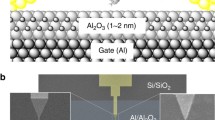Abstract
The theory of thermoelectric phenomena in a metal-molecule-metal conjunction has been developed in the case of resonance conduction through the molecule. It has been shown that the resonance current may cool one of the electrodes at the biases when the resonance level is near the Fermi level: at the electron resonance, the electron resonance level should be above the Fermi level of the cooled cathode and, at the hole resonance, the hole resonance level should be below the Fermi level of the cooled anode. The energy flux cooling the electrode is proportional to the resonance current, and each electron of the current removes energy somewhat higher than kT from the corresponding electrode. Such a molecular refrigerator is effective, while kT is higher than the total width of the resonance level. Peltier and Seebeck coefficients have been found for the case when the resonance level is near the Fermi level already at the zero bias.
Similar content being viewed by others
References
A. Nitzan and M. A. Ratner, “Electron Transport in Molecular Wire,” Science 300, 1384 (2003).
N. J. Tao, “Electron Transport in Molecular Junctions,” Nature Nanotechn. 1, 173 (2006).
S. Karthäuser, “Control of Molecule-Based Transport for Future Molecular Devices,” J. Phys.: Condens. Matter 23, 013001 (2011).
K. L. Grosse, M.-H. Bae, F. Lian, E. Pop, and W. P. King, “Nanoscale Joule Heating, Peltier Cooling and Current Crowding at Graphene-Metal Contacts,” Nature Nanotechn. 6, 287 (2011).
T. Shimada, Y. Ikuta, Y. Tsuchida, M. Ohtomo, and T. Hasegawa, “Computational Analysis of Thermal Energetic Disorder in a Pentacene Crystal: Temperature Dependence of Trap Levels and Possible Novel Thermoelectric Contribution,” Appl. Phys. Express 4, 061601 (2011).
A. Tan, S. Sadat, and P. Reddy, “Measurement of Thermopower and Current-Voltage Characteristics of Molecular Junctions to Identify Orbital Alignment,” Appl. Phys. Lett. 96, 013110 (2010).
D. I. Bolgov, M. A. Kozhushner, R. R. Muriasov, and V. S. Posvianskii, “Multicenter Scattering Theory of Mediator Effect in Electron Tunneling Transitions,” J. Chem. Phys. 119, 3871 (2003).
G. D. Mahan and J. O. Sofo, “The Best Thermoelectric,” Proc. Natl. Acad. Sci. USA 93, 7436 (1996).
Y. Dubi and M. Di Ventra, “Colloquium: Heat Flow and Thermo Electricity in Atomic and Molecular Junctions,” Rev. Mod. Phys. 83, 131 (2011).
C. M. Finch, V. M. Garcia-Suarez, and C. J. Lambert, “Giant Thermopower and Figure of Merit in Single-Molecule Devices,” Phys. Rev. B 79, 033405 (2009).
J. P. Bergfield and C. A. Stafford, “Thermoelectric Signatures of Coherent Transport in Single-Molecule Heterojunctions,” Nano Lett. 9, 3072 (2009).
M. A. Kozhushner, I. I. Oleynik, V. S. Posvyanskii, and L. Yu, “Rectification Mechanism in Di-Block Oligomer Molecular Diod,” Phys. Rev. Lett. 96, 096803 (2006).
S. Datta, Quantum Transport: From Atom to Transistor (Cambridge Univ. Press, Cambridge, 2005).
M. A. Kozhushner, V. S. Posvyanskii, and I. I. Oleynik, “Tunneling and Resonant Conductance in One-Dimensional Molecular Structures,” Chem. Phys. 319, 368 (2005).
A. A. Abrikosov, L. P. Gor’kov, and I. E. Dzyaloshinskii, Methods of Quantum Field Theory in Statistical Physics (GIFML, Moscow, 1962) [in Russian].
O. V. Gritsenko and E. J. Baerends, “Physical Interpretation and Evaluation of the Kohn-Sham and Dyson Components of the e-I Relations between the Kohn-Sham Orbital Energies and the Ionization Potentials,” J. Chem. Phys. 119, 1937 (2003).
Yu. Dahnovsky, V. G. Zakrzewski, A. Kletsov, and J. V. Ortiz, “Ab initio Electron Propagator Theory of Molecular Wires. I. Formalism,” J. Chem. Phys. 123, 184711 (2005).
L. Adamska, M. A. Kozhushner, and I. I. Oleynik, “Electron-Plasmon Interactions in Resonant Molecular Tunnel Junctions,” Phys. Rev. B 80, 108947 (2010).
M. P. Samanta, W. Tian, S. Datt, et al., “Electronic Conduction through Organic Molecules,” Phys. Rev. B 53, 7626 (1996).
C. Toher and S. Sanvito, “Efficient Atomic Self-Interaction Correction Scheme for Nonequilibrium Quantum Transport,” Phys. Rev. Lett. 99, 056801 (2007).
J. Taylor, M. Brandbyge, and K. Stokbro, “Conductance Switching in a Molecular Device: The Role of Side Groups and Intermolecular Interactions,” Phys. Rev. B 68, 121101 (2003).
D. Natelson, L. H. Yu, J. W. Ciszek, et al., “Single-Molecule Transistors: Electron Transfer in the Solid State,” Chem. Phys. 324, 267 (2006).
J. P. Bergfield and C. A. Stafford, “Many-Body Theory of Electronic Transport in Single-Molecule Heterojunctions,” Phys. Rev. B 79, 245125 (2009).
M. Galperin, M. A. Ratner, and A. Nitzan, “Molecular Transport Junctions: Vibrational Effects,” J. Phys.: Condens. Matter 19, 103201 (2007).
M. Galperin and A. Nitzan, “NEGF-HF Method in Molecular Junction Property Calculations,” Ann. Acad. Sci. New York 1006, 48 (2003).
M. Galperin, A. Nitzan, and M. A. Ratner, “Inelastic Tunneling Effects on Noise Properties of Molecular Junctions,” Phys. Rev. B 73, 045314 (2006).
M. K. Ng, D. C. Lee, and L. P. Yu, “Molecular Diodes Based on Conjugated Diblock Co-Oligomers,” J. Am. Chem. Soc. 124, 11862 (2002).
I. Diez-Perez, J. Hihath and Y. Lee, et al., “Rectification and Stability of a Single Molecular Diode with Controlled Orientation,” Nature Chem. 1, 635 (2009).
M. A. Kozhushner and I. I. Oleinik, “Molecular Oscillation Excitation by Resonant Current,” Zh. Eksp. Teor. Fiz. 142(10) (2012).
A. M. Kuznetsov, Charge Transfer in Physics, Chemistry and Biology (Gordon and Breach, New York, 1995).
S. I. Pekar, “The Theory of F-Centers,” Zh. Eksp. Teor. Fiz. 20, 50 (1950).
Kun. Huang and A. Rhys, “Theory of Light Absorption and Non-Radiative Transitions in F-Centers,” Proc. Roy. Soc. A 204, 406 (1950).
Yu. E. Perlin, “Modern Methods of Multiphoton Processes Theory,” Usp. Fiz. Nauk 80, 553 (1963).
Author information
Authors and Affiliations
Corresponding author
Additional information
Original Russian Text © M.A. Kozhushner, 2013, published in Rossiiskie Nanotekhnologii, 2013, Vol. 8, Nos. 1–2.
Rights and permissions
About this article
Cite this article
Kozhushner, M.A. Molecular refrigerator and thermoelectric phenomena under conditions of tunnel-resonance conductance. Nanotechnol Russia 8, 46–53 (2013). https://doi.org/10.1134/S1995078013010060
Received:
Accepted:
Published:
Issue Date:
DOI: https://doi.org/10.1134/S1995078013010060




